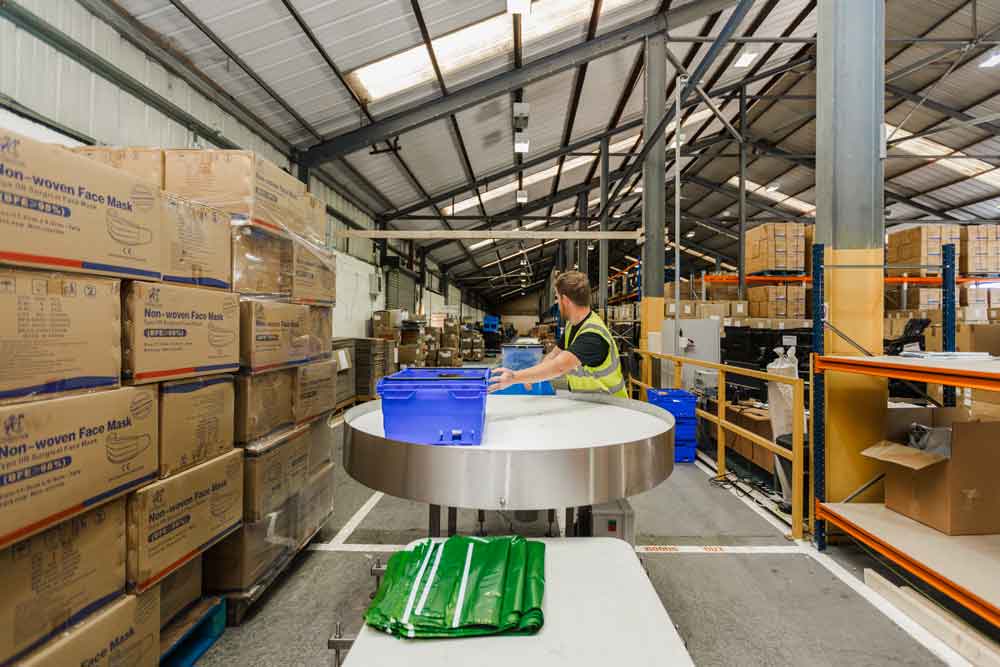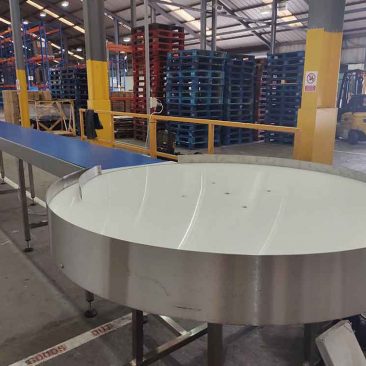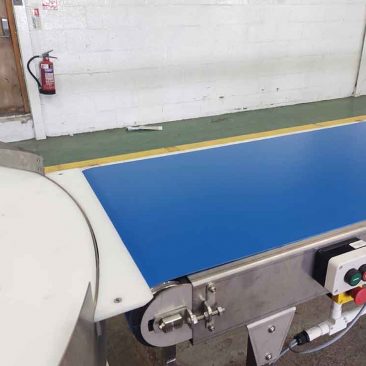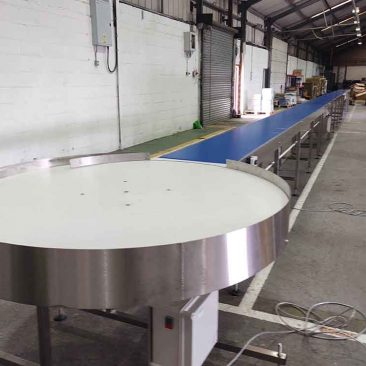
A Warehouse Transport Conveyor & Rotary Table made to suit our clients specs and requirements.
About the Company
In this instance the customer was a work uniform, work wear and PPE supplier and had contacted with a request for a Warehouse Transport Conveyor & Rotary Table system. The conveyor system was required in their main warehouse for transporting totes and boxes.
Rotary Table
| Product Type | Rotary Table |
| Dimensions | Diameter: 1500mm Height: 1000mm |
| Controls | Comes with control panel, fully wired |
| Features | Stainless steel frame Food safe top Cut out section and transfer plate |
Belt Conveyor
| Product Type | Stainless Steel Belt Conveyor |
| Dimensions | Length: 20 metres Width: 500mm Height: 1000mm |
| Controls | Comes with control panel, fully wired |
| Features | Stainless steel frame PVC Food Safe Belt |
Get a FREE Conveyor Quote today
We are the leading UK manufacturer of stand alone conveyors for integration or full conveyor systems
Email sales@conveyorsystems.co.uk with your enquiries
Advantages of Warehouse Transport Conveyors and Rotary Tables
Warehouse transport conveyors and rotary tables are essential in modern warehouse operations, offering numerous benefits that enhance efficiency, safety, and overall productivity. Here are the key advantages of these systems:
Benefits of Warehouse Transport Conveyors
1. Enhanced Efficiency and Speed
- Continuous Flow: Warehouse conveyors provide an automated, uninterrupted flow of goods, significantly reducing handling times and boosting throughput.
- Reduced Manual Labor: Automating product movement minimizes manual handling, allowing staff to focus on more complex tasks and improving overall productivity.
2. Improved Accuracy
- Consistent Movement: Conveyors offer consistent and precise movement of goods, reducing errors associated with manual transportation.
- Automated Sorting: Integrated sorting systems direct items to the correct locations, enhancing inventory management and order fulfillment accuracy.
3. Cost Savings
- Labor Costs: Automation reduces the need for a large workforce, lowering labor expenses.
- Operational Costs: Conveyors decrease wear and tear on other material handling equipment, reducing maintenance and repair costs.
4. Increased Safety
- Reduced Injuries: Automating the transport of heavy or bulky items reduces the risk of workplace injuries related to lifting and moving.
- Controlled Environment: Conveyors provide a controlled environment for product movement, minimizing the potential for damage.
5. Space Optimization
- Efficient Layout: Customizable conveyors fit the warehouse layout, optimizing space usage.
- Vertical Transport: Inclined and vertical conveyors efficiently use vertical space, maximizing storage capacity.
Benefits of Rotary Tables
1. Improved Workflow Integration
- Buffer Zone: Rotary tables act as buffer zones, holding items temporarily to prevent bottlenecks.
- Seamless Integration: They integrate seamlessly with conveyor systems, ensuring a smooth flow of products.
2. Enhanced Sorting and Distribution
- Multi-Directional Movement: Rotary tables rotate items in different directions, facilitating easier sorting and distribution.
- Flexible Handling: They handle a variety of products, enhancing operational flexibility.
3. Increased Productivity
- Reduced Handling Time: Minimizing manual handling speeds up processes.
- Quick Access: Rotary tables provide quick access to items from different directions, improving loading and unloading efficiency.
4. Versatility
- Customizable Solutions: Rotary tables can be tailored to specific operational needs, handling various product sizes and types.
- Adaptable: Suitable for various applications, from assembly lines to packing stations.
5. Enhanced Safety
- Stable Platform: Rotary tables offer a stable platform for items, reducing the risk of product damage and workplace injuries.
- Ergonomic Design: They create a more ergonomic working environment, reducing excessive reaching and lifting.
Conclusion
Integrating warehouse transport conveyors and rotary tables into your operations delivers enhanced efficiency, accuracy, safety, and cost savings. These systems optimize the flow of goods, making them indispensable for modern, high-volume warehouse and distribution centers. By leveraging these technologies, businesses can significantly improve their material handling processes and overall operational performance.






